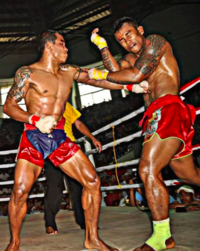Mainland Southeast Asia martial arts
The traditionalmartial artsof theMainland Southeast Asiaare related to one another, and as a group toIndian martial arts.The most salient common feature is Mainland Southeast Asiakickbo xing.The region ofMainland Southeast Asiais believed to be the land ofSuvarnabhumithat ancient Indians mentioned in Buddhist text and Hindu text. In 790 A.D., aKhmerprince who grew up abroad by the name ofJayavarman IIreturned to unify the Khmer civilization. In 802 A.D., Jayavarman II established theKhmer Empire,the precursor to modern Cambodia, and declared himself theChakravatin(universal ruler).[1]Around 850 A.D.,Pagan,the ancestor of modern-dayBurma,was established by Tibeto-Burman speakers.[2]For 200 years, Pagan remained a small principality until the reign of KingAnawrahta.[3]In 1238 A.D., Thailand's first state,Sukhothai,was started when the residents declared independence from theKhmer Empire.In 1353 A.D., Laos's first state,Lan Xang,was started byFa Ngumwith the assistance of theKhmerfromAngkor.[4]
Myanmar[edit]

Thaing(Burmese:သိုင်း,pronounced[θáiɰ̃]) is aBurmese termused to classify the traditionalmartial systemsofMyanmar.There are three main generation of Thaing in Myanmar, named "Kanbawza" "Inwa" and "Yamanya". Burmese martial arts includebando,banshay,naban,shan gyiandLethwei:
Lethweior Burmese bo xing. A traditional style of striking withheadbutts,kicks, punches,kneeandelbow strikes.[5]
Nabanis the traditional form of wrestling from Myanmar. Originally based on Indian wrestling, it is practiced primarily in rural areas. Naban is especially popular among the Himalayan tribes. The Chin and Kachin people are both known for their skilled wrestlers. Techniques include joint locks, strikes to pressure points, and chokeholds.
Cambodia[edit]
Bokatoris an ancientCambodianmartial artwith roots in the 1st century. It prioritises physical and mental development through strength, discipline, and a commitment to non-violence. It combines physical combat techniques with a strong focus on mental discipline rooted in respect for nature and societal values. Masters, some believed to possess special healing and protective abilities, guide apprentices in understanding their roles and responsibilities, ultimately preparing them to safeguard communities, the environment, and advocate for justice and peace. Bokator remains an integral part ofCambodian culture,not only as a martial art but also in rituals dedicated to local deities and festive events. These occasions often incorporate traditional elements like dance, music, and traditional medicine. Bokator symbolises Cambodia's cultural, social, and religious values and enjoys a broad following across age, gender, education, and social status.[6]
Kun KhmerorPradal Sereyis an unarmedmartial artfromCambodia.InKhmerthe wordpradalmeans fighting or bo xing andsereymeans free. Originally used for warfare, pradal serey is now one of Cambodia's national sports. Its moves have been slightly altered to comply with the modern rules. The martial art was turned into a sport when French colonists arrived and added components of Westernbo xingsuch as a bo xing ring, bo xing gloves, weight classes and timed rounds.

Khmer traditional wrestlingis afolk wrestlingstyle fromCambodia.It has been practiced as far back as theAngkorperiod and is depicted on the bas-reliefs of certain temples. The earliest form of Khmer traditional wrestling was called Maloyuth. Maloyuth was created in 788 A.D. byBrahminTimu.[7]It evolved to the current form of wrestling, Cham Bab, in the 8th century. Although predominantly a male sport today, Khmer wrestling was once practiced by both sexes as female wrestlers are also displayed on theBanteay Sreitemple.
Laos[edit]
Muay Laois a traditional unarmedmartial artfromLaos.It incorporates punches, kicks, elbows and knee strikes. Muay Lao was an event at the2009 Southeast Asian GamesinVientiane.
Malaysia[edit]
Tomoiis an unarmedmartial artfromMalaysia.It is practiced mainly in the northern states such asKedah,Trengganu,and especiallyKelantan.
Thailand[edit]

Muay Boran(Thai:มวยโบราณ,RTGS:muai boran,pronounced[mūa̯jbōːrāːn];lit. 'ancient bo xing') is an umbrella term for the unarmedmartial artsofThailandprior to the introduction of modern equipment and rules in the 1930s. It is the predecessor of modernMuay Thaior Thai bo xing.
Muay Thai(Thai:มวยไทย,RTGS:muai thai,pronounced[mūa̯jthāj];lit. 'Thai bo xing') is the Thai style of striking with strong emphasis on kicks, punches,kneeandelbow strikes.[8]
Krabi-Krabong(Thai:กระบี่กระบอง,pronounced[krā.bìːkrā.bɔ̄ːŋ]) is a Thai weapon-based martial art. Krabi-krabong was developed by the ancientSiamesewarriors for fighting on the battlefield. It was likely used in conjunction with muay boran but whether the two arts were developed together or independently is uncertain. Early warfare in Indochina was mostly between rival kingdoms and were fought en masse. Individual fighters were armoured and carriedrhinohide shields. The system's name refers to its main weapons, namely the Thai sword (krabi) and staff (krabong). Typically, two swords (daab song mue) are wielded as a pair. Unarmed krabi-krabong (muay boran) makes use of kicks, pressure point strikes, joint locks, holds, and throws.
Vietnam[edit]
Traditional Vietnamese martial arts(Võ Thuật Cổ Truyền Việt NamVõ thuật cổ truyền Việt Nam ) can be loosely divided into those of the Sino-Vietnamese descended from the Han, and those of theChamsor indigenous Vietnamese.Qwan Ki DoandVovinamare prominent modern Vietnamese martial arts.[9]
References[edit]
- ^Johnson, D., & Young, D. (Producers), & Mose, C. (Director). (2020). Cambodia's Temple Kingdom | The Mark Of Empire | Angkor [Film]. CNA Insider.
- ^"Myanmar - Pyu State, Ancient Cities, Irrigation | Britannica".britannica.Retrieved2024-05-07.
- ^Johnson, D., Young, D., & Shapudin, N. (Producers), & Mose, C. (Director). (2020). Myanmar's Unifying Kingdom | The Mark Of Empire | Bagan [Film]. CNA Insider.
- ^"Laos - French Colonialism, Communist Revolution, Mekong River | Britannica".britannica.Retrieved2024-05-07.
- ^Calderon, Justin (23 September 2014)."Punches, headbutts, knockouts: Asia's 'new' martial arts sensation".CNN.
- ^"Kun Lbokator, traditional martial arts in Cambodia".unesco.org.
- ^"The Kingdom's oldest wrestling form grapples with fading interest".April 7, 2017 – via Phnom Penh Post.
- ^"Get in shape at a Thai kickbo xing camp".USA Today.2008-10-15.Retrieved2010-12-07.
- ^Green 2010,p. 549.
- Draeger, Donn F.; Smith, Robert W. (1980).Comprehensive Asian Fighting arts.Tokyo: E. Kodansha.ISBN978-4-77000-913-5.
- Green, Thomas A. (2010). "Southeast Asia". In Green, Thomas A.; Svinth, Joseph R. (eds.).Martial Arts of the World: An Encyclopedia of History and Innovation· Volume 1.Santa Barbara, California: ABC-CLIO. pp. 538–550.ISBN978-1-59884-243-2.
